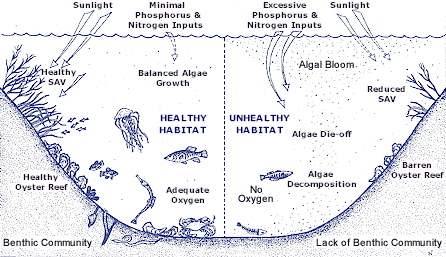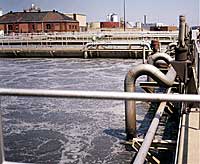 | ||||||||||
 |
Policy and ManagementNutrients & Organic MatterWhat are the pollutants? Two major nutrients found in all estuaries including Narragansett Bay are phosphorus and nitrogen. Organic matter that flows into the Bay contains large amounts of these nutrients. Both phosphorus and nitrogen are essential for the growth of phytoplankton. However when they are found in excess, they become harmful to the estuarine communities. Where do they come from? In the past, sewage treatment plants were considered a major source of nutrient inputs into aquatic systems. Though wastewater treatment facilities still contribute nutrients, a great deal of progress has been made in reducing the levels of nitrogen and phosphorus introduced into Narragansett Bay through pre-treatment programs, facility upgrades and maintenance. Today, failing septic systems, fertilizers, atmospheric deposition, and domestic animal waste constitute a significant portion of nutrients introduced into rivers, streams, and estuaries. These sources find their way to Narragansett Bay via washing through combined sewer overflows or by discharging directly into the Bay as runoff. Additional sources of nutrient inputs include improperly disposed of sewage from vessels in the Bay, erosion of nitrogen and phosphorus-containing rocks and soils, and even small inputs from everyday household items such as detergents, toothpaste, and pharmaceuticals. Though these types of inputs are small, the cumulative affect can be substantial. Nutrient inputs to other rivers in the Narragansett Bay watershed also influence the input of nutrients and overall health of the Bay. Nitrogen and phosphorus loadings to the Moshassuck, Woonasquatucket, West, Ten Mile, and Blackstone Rivers all affect the nutrient concentrations in the Seekonk and Providence River, which contribute to the upper Narragansett Bay. Organic material from the Blackstone River also contributes to the input of nutrients. The Blackstone flows into the Providence River which flows into Narragansett Bay. When the level of nutrients is high in the Blackstone River, its output will flow into the Providence River therefore affecting Narragansett Bay. How do they affect Narragansett Bay? Moderate levels of nutrients are essential to support the food chains in the Bay. However, when excess levels of nitrogen and phosphorus are present, and increase in primary production and an explosive growth of phytoplankton can result. Phytoplankton will reproduce rapidly into a large bloom; nutrients will be consumed until they are depleted. Without a food supply, the large population of phytoplankton will then collapse. When the plankton begin to die off and break down, the process of decomposition will use up oxygen dissolved in the water column. As oxygen levels decline, the ecosystem will no longer be able to support fish, crabs, and other aquatic life. This low-oxygen condition is known as hypoxia.
If inputs of nitrogen and phosphorus are sustained, eutrophic conditions can occur. Eutrophication is a natural process in some bodies of water, but human activities can greatly accelerate the rates at which nutrients enter an aquatic system. Agricultural and urban runoff, leaking septic systems, sewage discharges, and eroded stream banks are some of the major sources of nutrient inputs into the Bay. Eutrophication results where high nutrient concentrations have stimulated the growth and blooms of algae. These resultant algae blooms cause problems in two ways. First, blooms of algae cloud the water and block sunlight from underwater grasses and plants. This leaves these plants and grasses unable to photosynthesize and produce food; consequently, they will soon die. Loss of underwater plants and grasses results in the decrease of food and shelter for aquatic creatures, as well as a decline in oxygen released into the water column as a byproduct of photosynthesis. The Providence River, which flows into Narragansett Bay, has a severe dissolved oxygen problem and is due to the eutrophication process. Most of the nutrients that enter the river come from organic matter that is found in the wastewater treatment plants or from the coastal development and the untreated drainage on roads and in parking lots. Too many nutrients and too much organic matter entering the Bay will cause depletion in oxygen. Nutrients and organic matter are important for sustaining the productivity of the Bay. Problems arise when both nutrients and organic matter are present in excessive levels. What is being done about them? Nutrient control is a potential costly issue due to the many sources of nutrient pollution. Sewage treatment plants have ways of removing the nutrients from the wastewater, which can reduce the amount of nutrient pollution entering the Bay. The Rhode Island Department of Environmental Management has also started to incorporate limits on nutrients into its permits for wastewater treatment plants. However, there are still nine sewage treatment plants that are discharging directly into Narragansett Bay. The sewage treatment plants are implementing methods of controlling the amount of pollution being discharged into the Bay. Perhaps one of the most important steps in reducing nutrient inputs into Narragansett Bay is the Narragansett Bay Commission's (NBC) Combined Sewer Overflow Abatement Project. Sewer systems were originally built to carry rain water and sewage in the same pipe (called a combined sewer). During heavy rainstorms, these combined flows often exceed the capacity of the system and overflow into the Bay and its tributaries. For more information, visit the Narragansett Bay Commission web site: http://www.narrabay.com.
|
|||||||||

